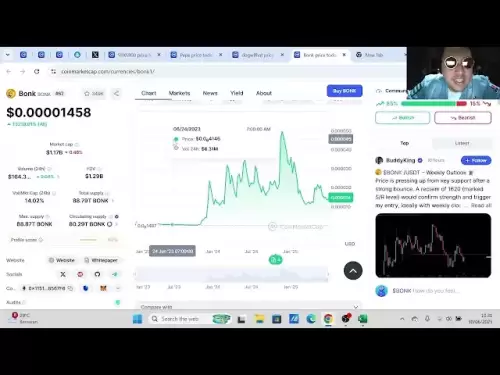-
 Bitcoin
Bitcoin $108,489.6704
1.13% -
 Ethereum
Ethereum $2,502.0528
2.92% -
 Tether USDt
Tether USDt $1.0002
0.00% -
 XRP
XRP $2.1941
0.51% -
 BNB
BNB $655.3375
1.00% -
 Solana
Solana $151.5977
1.27% -
 USDC
USDC $0.9999
0.00% -
 TRON
TRON $0.2768
0.32% -
 Dogecoin
Dogecoin $0.1676
2.86% -
 Cardano
Cardano $0.5675
0.98% -
 Hyperliquid
Hyperliquid $40.6109
7.48% -
 Bitcoin Cash
Bitcoin Cash $500.7746
2.09% -
 Sui
Sui $2.8328
2.03% -
 Chainlink
Chainlink $13.4452
1.26% -
 UNUS SED LEO
UNUS SED LEO $9.1623
0.39% -
 Avalanche
Avalanche $18.2267
2.24% -
 Stellar
Stellar $0.2382
0.00% -
 Toncoin
Toncoin $2.8885
1.68% -
 Shiba Inu
Shiba Inu $0.0...01159
0.91% -
 Litecoin
Litecoin $87.1827
0.88% -
 Hedera
Hedera $0.1511
2.90% -
 Monero
Monero $315.4992
-0.59% -
 Polkadot
Polkadot $3.4663
2.34% -
 Bitget Token
Bitget Token $4.6118
-0.65% -
 Dai
Dai $1.0000
-0.01% -
 Ethena USDe
Ethena USDe $1.0003
0.02% -
 Uniswap
Uniswap $7.2989
4.69% -
 Pepe
Pepe $0.0...01003
5.73% -
 Aave
Aave $275.5616
7.15% -
 Pi
Pi $0.5181
-2.49%
How to adjust the leverage multiple of LBank contract? Will the position be affected after the leverage adjustment?
Adjusting leverage on LBank changes margin requirements but not position size; higher leverage increases potential profit/loss and liquidation risk.
May 05, 2025 at 10:14 pm

How to Adjust the Leverage Multiple of LBank Contract? Will the Position Be Affected After the Leverage Adjustment?
Trading with leverage is a common practice in the cryptocurrency market, particularly on platforms like LBank, where users can amplify their trading positions. One of the critical aspects of trading with leverage is understanding how to adjust the leverage multiple and what effects such adjustments have on existing positions. This article will guide you through the process of adjusting the leverage multiple on LBank and explain whether your position will be affected after making these changes.
Understanding Leverage on LBank
Leverage is essentially borrowed capital provided by the exchange that allows traders to increase their exposure to a financial asset without needing to commit the full amount of capital. On LBank, leverage is available for futures and perpetual contracts, and it can be adjusted to suit the trader's risk appetite and market outlook.
Leverage is expressed as a multiple, such as 1x, 5x, 10x, or even higher, depending on the asset and the exchange's policies. Higher leverage means higher potential returns but also higher risk, as losses can exceed the initial margin.
Steps to Adjust the Leverage Multiple on LBank
Adjusting the leverage multiple on LBank is a straightforward process. Here are the steps you need to follow:
Log into Your LBank Account: Ensure you are logged into your LBank account. Navigate to the futures or perpetual contract trading section.
Select the Contract: Choose the specific futures or perpetual contract for which you want to adjust the leverage. This could be Bitcoin, Ethereum, or any other supported cryptocurrency.
Access the Leverage Settings: Once you have selected the contract, look for the leverage adjustment option. This is usually found under the trading interface or within the settings menu.
Adjust the Leverage Multiple: You will see a slider or a dropdown menu that allows you to select the desired leverage multiple. Move the slider or select the appropriate value from the dropdown menu.
Confirm the Adjustment: After setting the new leverage multiple, confirm the change. Some platforms may require you to enter your password or use two-factor authentication to proceed.
Review the Position: Once the leverage is adjusted, review your position to ensure the changes have been applied correctly.
Will the Position Be Affected After the Leverage Adjustment?
When you adjust the leverage on an existing position, it is important to understand how this change impacts your trade. Here's what happens:
Margin Requirements: Adjusting the leverage multiple will change the margin requirements for your position. Higher leverage means lower margin requirements, and vice versa. If you increase the leverage, the amount of margin required to maintain your position will decrease. Conversely, if you decrease the leverage, you may need to add more margin to meet the new requirements.
Position Size: The size of your position remains the same after adjusting the leverage. However, the amount of capital at risk changes. Increasing leverage increases the potential profit or loss for the same position size, while decreasing leverage reduces it.
Profit and Loss (P&L): The adjustment of leverage does not directly affect the unrealized P&L of your position. However, since the amount of capital at risk changes, the impact of price movements on your P&L will be different. Higher leverage means that price movements will have a more significant impact on your P&L.
Liquidation Risk: Changing the leverage multiple can also affect your liquidation price. Higher leverage increases the risk of liquidation, as the margin buffer between your position and the liquidation price becomes smaller. Conversely, lower leverage provides a larger margin buffer, reducing the risk of liquidation.
Practical Example of Leverage Adjustment
To illustrate how leverage adjustment works, let's consider a practical example. Suppose you have an open position in Bitcoin futures with a size of 1 BTC and a leverage of 10x. The current market price of Bitcoin is $30,000, and you have used $3,000 as your initial margin (10% of the position value).
If you decide to increase the leverage to 20x, the margin requirement for your position will decrease to $1,500 (5% of the position value). However, the size of your position remains 1 BTC, and the unrealized P&L remains the same at the time of adjustment. The increased leverage means that price movements will have a more significant impact on your P&L, and your liquidation price will be closer to the current market price.
Conversely, if you decrease the leverage to 5x, the margin requirement will increase to $6,000 (20% of the position value). The size of your position and the unrealized P&L remain the same, but the impact of price movements on your P&L will be less significant, and your liquidation price will be further away from the current market price.
Tips for Managing Leverage Adjustments
Managing leverage adjustments effectively is crucial for successful trading. Here are some tips to consider:
Monitor Margin Levels: Always keep an eye on your margin levels after adjusting the leverage. Ensure you have sufficient margin to cover potential losses and avoid liquidation.
Understand the Risks: Be aware of the increased risk associated with higher leverage. Only use leverage that you are comfortable with and that aligns with your risk management strategy.
Adjust Gradually: If you are new to leverage trading, consider adjusting the leverage gradually to understand how it affects your positions and P&L.
Use Stop-Loss Orders: Implementing stop-loss orders can help manage the risk of sudden price movements, especially when trading with higher leverage.
Frequently Asked Questions
Q1: Can I adjust the leverage multiple on an open position at any time?
Yes, you can adjust the leverage multiple on an open position at any time on LBank. However, be aware of the immediate changes to your margin requirements and potential impact on your P&L.
Q2: What happens if I don't have enough margin after adjusting the leverage?
If you do not have enough margin after adjusting the leverage, your position may be at risk of liquidation. It is essential to ensure you have sufficient margin to cover the new requirements before making any adjustments.
Q3: Does adjusting the leverage affect the fees I pay on LBank?
Adjusting the leverage does not directly affect the trading fees you pay on LBank. However, the fees are calculated based on the position size and the type of contract, so indirect effects may occur if the position size changes due to leverage adjustments.
Q4: Can I use different leverage multiples for different contracts on LBank?
Yes, you can use different leverage multiples for different contracts on LBank. Each contract can have its own leverage setting, allowing you to tailor your trading strategy to the specific asset and market conditions.
Disclaimer:info@kdj.com
The information provided is not trading advice. kdj.com does not assume any responsibility for any investments made based on the information provided in this article. Cryptocurrencies are highly volatile and it is highly recommended that you invest with caution after thorough research!
If you believe that the content used on this website infringes your copyright, please contact us immediately (info@kdj.com) and we will delete it promptly.
- Bitcoin's Bumpy Ride: Profit-Taking Slows Momentum, What's Next?
- 2025-06-30 20:30:11
- Bitcoin's Price Stall: Decoding the ETF Inflows Mystery
- 2025-06-30 20:30:11
- Ripple XRP, Bitcoin, and Solaris Presale: What's the Buzz?
- 2025-06-30 18:50:11
- SpaceX, Mirror Tokens, and Investors: A Wild Ride to the Future?
- 2025-06-30 19:10:22
- Arbitrum (ARB) and Robinhood: Partnership Rumors Fuel Price Surge to $0.4289?
- 2025-06-30 19:10:22
- Jasmy Coin, Bitcoin, and the Rise of Solaris Presale: What's the Buzz?
- 2025-06-30 18:30:12
Related knowledge
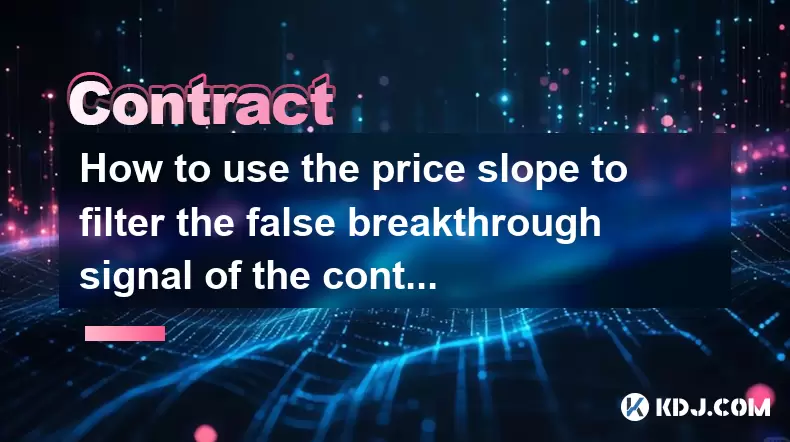
How to use the price slope to filter the false breakthrough signal of the contract?
Jun 20,2025 at 06:56pm
Understanding the Concept of Price Slope in Contract TradingIn contract trading, especially within cryptocurrency derivatives markets, price slope refers to the rate at which the price changes over a specific time period. It helps traders assess the strength and sustainability of a trend. A steep slope may indicate strong momentum, while a shallow slope...
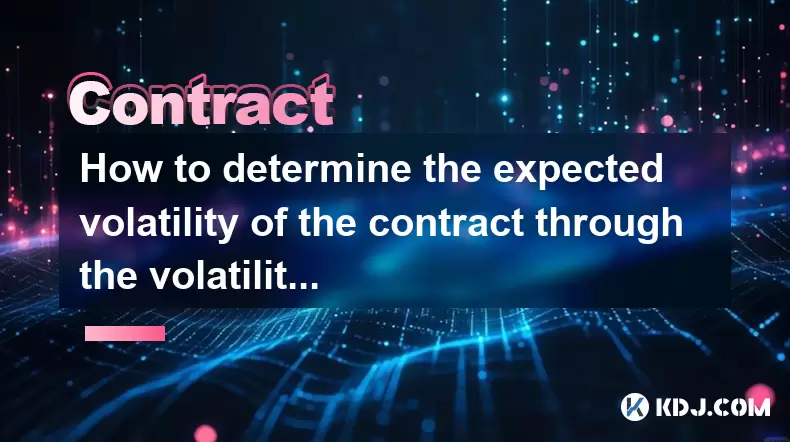
How to determine the expected volatility of the contract through the volatility cone?
Jun 19,2025 at 12:28pm
Understanding the Basics of Volatility in Cryptocurrency ContractsIn the realm of cryptocurrency trading, volatility is a key metric that traders use to assess potential risk and reward. When dealing with futures contracts, understanding how volatile an asset might become over time is crucial for position sizing, risk management, and strategy developmen...

How to formulate a contract intraday trading plan in combination with the pivot point system?
Jun 21,2025 at 03:42pm
Understanding the Basics of Pivot Points in Cryptocurrency TradingPivot points are technical analysis tools used by traders to identify potential support and resistance levels. These levels are calculated using the previous day's high, low, and closing prices. In the context of cryptocurrency trading, where markets operate 24/7, pivot points help trader...
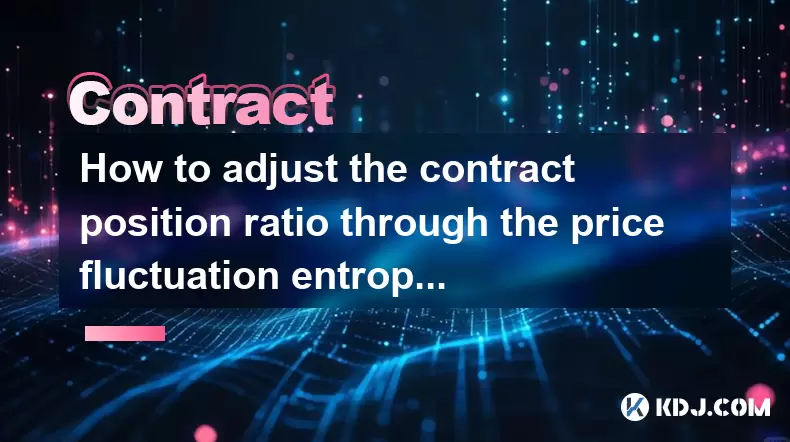
How to adjust the contract position ratio through the price fluctuation entropy?
Jun 22,2025 at 11:42am
Understanding Price Fluctuation Entropy in Cryptocurrency ContractsIn the world of cryptocurrency futures trading, price fluctuation entropy is a relatively new concept used to measure market volatility and uncertainty. It derives from information theory, where entropy refers to the degree of randomness or unpredictability in a system. In crypto contrac...
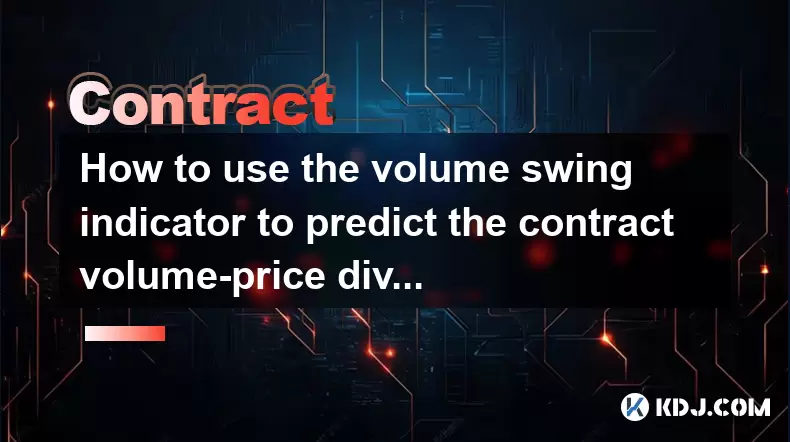
How to use the volume swing indicator to predict the contract volume-price divergence?
Jun 18,2025 at 11:42pm
Understanding the Volume Swing IndicatorThe volume swing indicator is a technical analysis tool used primarily in cryptocurrency trading to evaluate changes in volume over time. Unlike price-based indicators, this metric focuses solely on trading volume, which can provide early signals about potential market reversals or continuations. The key idea behi...

How to use the Gaussian channel to set the contract trend tracking stop loss?
Jun 18,2025 at 09:21pm
Understanding the Gaussian Channel in Cryptocurrency TradingThe Gaussian channel is a technical indicator used primarily in financial markets, including cryptocurrency trading, to identify trends and potential reversal points. It is based on statistical principles derived from the normal distribution, commonly known as the Gaussian distribution or bell ...

How to use the price slope to filter the false breakthrough signal of the contract?
Jun 20,2025 at 06:56pm
Understanding the Concept of Price Slope in Contract TradingIn contract trading, especially within cryptocurrency derivatives markets, price slope refers to the rate at which the price changes over a specific time period. It helps traders assess the strength and sustainability of a trend. A steep slope may indicate strong momentum, while a shallow slope...

How to determine the expected volatility of the contract through the volatility cone?
Jun 19,2025 at 12:28pm
Understanding the Basics of Volatility in Cryptocurrency ContractsIn the realm of cryptocurrency trading, volatility is a key metric that traders use to assess potential risk and reward. When dealing with futures contracts, understanding how volatile an asset might become over time is crucial for position sizing, risk management, and strategy developmen...

How to formulate a contract intraday trading plan in combination with the pivot point system?
Jun 21,2025 at 03:42pm
Understanding the Basics of Pivot Points in Cryptocurrency TradingPivot points are technical analysis tools used by traders to identify potential support and resistance levels. These levels are calculated using the previous day's high, low, and closing prices. In the context of cryptocurrency trading, where markets operate 24/7, pivot points help trader...

How to adjust the contract position ratio through the price fluctuation entropy?
Jun 22,2025 at 11:42am
Understanding Price Fluctuation Entropy in Cryptocurrency ContractsIn the world of cryptocurrency futures trading, price fluctuation entropy is a relatively new concept used to measure market volatility and uncertainty. It derives from information theory, where entropy refers to the degree of randomness or unpredictability in a system. In crypto contrac...

How to use the volume swing indicator to predict the contract volume-price divergence?
Jun 18,2025 at 11:42pm
Understanding the Volume Swing IndicatorThe volume swing indicator is a technical analysis tool used primarily in cryptocurrency trading to evaluate changes in volume over time. Unlike price-based indicators, this metric focuses solely on trading volume, which can provide early signals about potential market reversals or continuations. The key idea behi...

How to use the Gaussian channel to set the contract trend tracking stop loss?
Jun 18,2025 at 09:21pm
Understanding the Gaussian Channel in Cryptocurrency TradingThe Gaussian channel is a technical indicator used primarily in financial markets, including cryptocurrency trading, to identify trends and potential reversal points. It is based on statistical principles derived from the normal distribution, commonly known as the Gaussian distribution or bell ...
See all articles























